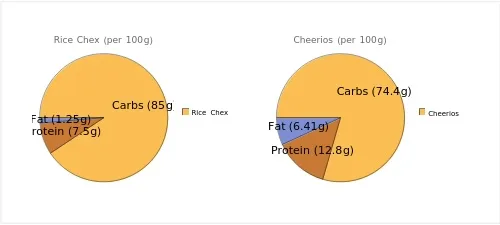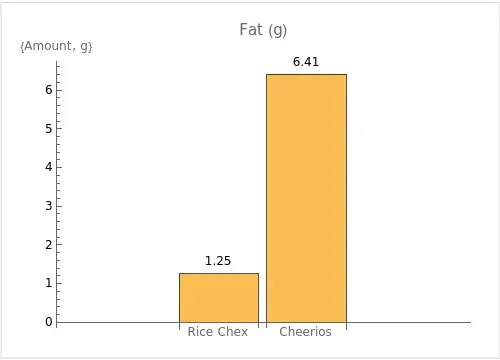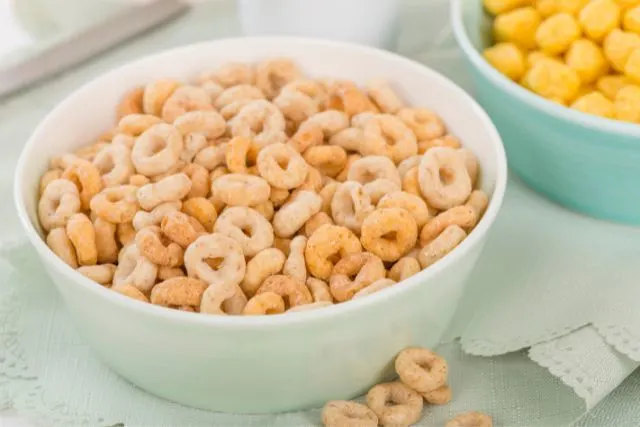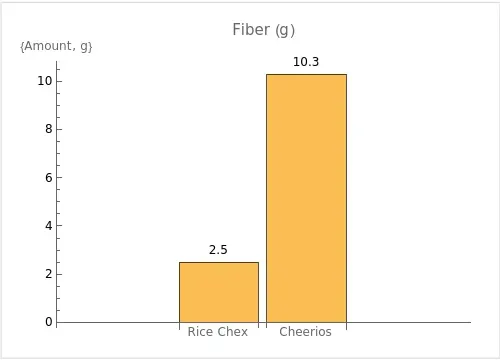Whether you are on a gluten-free diet because of a medical condition or you are simply trying to eat better, Rice Chex and Cheerios are two popular gluten-free options. These cereals are also nice options for anyone looking for a cereal that is not overly sweetened with added ingredients.
Rice Chex is made from rice and Cheerios is made from whole-grain oats. Both seem like healthy options, but how do they compare nutritionally to each other? Is one a healthier option than the other?
In this article, I will be doing a complete comparison of Rice Chex and Cheerios side-by-side. I will be comparing everything from their ingredients, the nutritional content, how they taste, and even how much they cost. I want to know if one is a healthier option than the other.

Rice Chex vs. Cheerios Nutritional Comparison
I will be basing this comparison on the nutritional information gathered from the USDA website and General Mills. The information gathered for each category is not a comprehensive list but by the end of the article, you will have enough information to decide for yourself which cereal is right for you and your family.
For the sake of this comparison, I will only be comparing regular/plain Rice Chex and Cheerios. Each category will have a winner but by the end of the article, you will have the information you need to decide which cereal is right for you and your family.
The recommended serving size for each cereal varies slightly. A serving of Rice Chex is 1 ⅓ cup or 40 grams. A serving of Cheerios is 1 ½ cups or 39 grams. Since there is a slight variation in serving size, I will also do a more accurate weight-for-weight comparison of 100 grams per serving for each kind of cereal.
Rating Criteria Key:
- 🟢 Green: Low
- 🟡 Yellow: Moderate
- 🔴 Red: High
Nutritional Comparison:
| Nutritional Category | Rice Chex | Cheerios |
|---|---|---|
| Calories (per 100g) | 🔴 Red | 🟡 Yellow |
| Carbs (per 100g) | 🔴 Red | 🟡 Yellow |
| Sugar (per 100g) | 🔴 Red | 🟢 Green |
| Protein (per 100g) | 🟡 Yellow | 🔴 Red |
| Fat (per 100g) | 🟢 Green | 🔴 Red |
| Fiber (per 100g) | 🟢 Green | 🟢 Green |
| Sodium (per 100g) | 🔴 Red | 🟢 Green |
Best for Calorie Content
The first item on every nutritional label is the calorie count so that’s where I’m starting this comparison. It’s important to mention that calories are not bad; our body needs calories for energy.
The problem is when we consume more calories than we burn. This is what leads to weight gain. I know I don’t want to start my day off consuming a lot of needless calories.
When comparing the calorie content of popular cereals, both Rice Chex and Cheerios fall in the moderate range. Specifically, Rice Chex contains 160 calories per serving, while Cheerios is slightly lower with 140 calories per serving. Choose based on your dietary needs.
|
Cereal Type |
Calories Per Serving |
Calories Per 100g |
|
Rice Chex |
160 kcal (40g) |
375 kcal |
|
Cheerios |
140 (39g) |
359 kcal |
Best for Carbs & Sugar Content

Carbs and sugar are another area where, in themselves, they are not bad. When we consume too many carbs and sugars, or the wrong kinds, our bodies react negatively such as making us feel fatigued or the dreaded weight gain.
Cereal, in general, is naturally high in carbs. Rice Chex and Cheerios are no exception. Rice Chex and Cheerios are both high in carbs but Cheerios has fewer carbs per serving than Rice Chex.
A serving size of Rice Chex has 35 grams of carbs per serving compared to 29 grams in a serving size of Cheerios.
|
Cereal Type |
Carbs Per Serving |
Carbs Per 100g |
|
Rice Chex |
35g (40g) |
85g |
|
Cheerios |
29g (39g) |
74.4g |
One of the reasons why Rice Chex and Cheerios are popular cereals is because they are not loaded with extra sugar and other sweeteners. This is one of the reasons why so many of us feel they are healthy options.
Rice Chex does have added sugar and molasses which causes it to have a slightly higher sugar content than Cheerios, but both Rice Chex and Cheerios are low in sugar.
|
Cereal Type |
Sugar Per Serving |
Sugar Per 100g |
|
Rice Chex |
3g (40g) |
7.5g |
|
Cheerios |
2g (39) |
5.13 |
Best for Protein Content
Since Rice Chex and Cheerios are both considered whole-grain cereals, we don’t often think about the protein content. It’s important to make sure you are getting enough protein in your diet.
As we’re always telling our kids, protein helps you grow big and strong. Protein helps strengthen our bones, aids our muscles in repair and recovery after exercise, and plays a vital role in having healthy joints and skin.
Unfortunately, neither Rice Chex nor Cheerios are high in protein but you can easily increase the protein content of your cereal by adding high-protein milk.
Cheerios has 5 grams of protein per serving whereas Rice Chex has 3 grams.
|
Cereal Type |
Protein Per Serving |
Protein Per 100g |
|
Rice Chex |
3g (40g) |
7.5g |
|
Cheerios |
5g (39) |
12.8g |
Best for Fat Content
Aside from being low in sugar and gluten-free, another reason both Rice Chex and Cheerios are popular choices is because they are both low in fat content. For this category, Rice Chex contains less fat than Cheerios.
|
Cereal Type |
Fat Content Per Serving |
Fat Content Per 100g |
|
Rice Chex |
1g (40g) |
1.25g |
|
Cheerios |
2.5g (39) |
6.41g |

Best for Fiber Content

Fiber is one category that is often overlooked. Fiber has the reputation for keeping our colons healthy but there is so much more to this underappreciated ingredient.
Fiber helps keep you fuller for longer. This is important if you are someone who is trying to lose or maintain weight. The fullness of fiber will prevent you from snacking too much between meals.
Another benefit of fiber is that it helps you maintain healthy blood sugar and cholesterol levels. Eating a high-fiber diet will help you have more energy, too. All good things when you are trying to get healthy.
Per serving, Rice Chex and Cheerios contain the same amount of fiber. When compared by weight, according to the USDA website, Cheerios has more than double the amount of fiber in Rice Chex.
|
Cereal Type |
Fiber Content Per Serving |
Fiber Content Per 100g |
|
Rice Chex |
2g (40g) |
2.5g |
|
Cheerios |
2g (39g) |
10.3g |

Best for Sodium/Salt Content
Sodium/salt content is another area that needs investigating. Sodium is a beneficial mineral when consumed in moderation. Consuming too much sodium can lead to various health issues such as high blood pressure and even kidney issues.
Cheerios is much lower in sodium when compared to Rice Chex. Cheerios has 190 mg of sodium per serving. Rice Chex has 330 mg. If you have to monitor your sodium intake, Cheerios is the winner for you.
|
Cereal Type |
Sodium Per Serving |
Sodium Per 100g |
|
Rice Chex |
330mg (40g) |
800mg |
|
Cheerios |
190 mg (39g) |
487 mg |
Best for Vitamins/Minerals
Rice Chex and Cheerios are both fortified cereals, meaning they both have added vitamins and minerals to help increase the nutritional value of each cereal.
Rice Chex and Cheerios contain the same amounts of vitamin A, calcium, vitamin B12, niacin, folate, and zinc. Cheerios contain a higher amount of magnesium and potassium.
You can visit the USDA website for a more comprehensive list of the vitamins and minerals found in Rice Chex and Cheerios.
|
Vitamin/Mineral Type |
Rice Chex Daily Value % |
Cheerios Daily Value % |
|
Vitamin D |
10% |
10% |
|
Iron |
70% |
70% |
|
Vitamin A |
10% |
10% |
|
Niacin |
10% |
10% |
|
Folate |
20% |
20% |
|
Zinc |
20% |
20% |
|
Calcium |
10% |
10% |
|
Potassium |
0 |
6% |
|
Vitamin C |
10% |
10% |
|
Vitamin B6 |
20% |
20% |
|
Vitamin B12 |
20% |
20% |
|
Magnesium |
6% |
10% |
Best for Flavor/Texture
Rice Chex and Cheerios are both fairly bland cereals when it comes to taste. I find Rice Chex to have a slightly sweeter taste than Cheerios. The nice thing about both kinds of cereal having a neutral flavor profile is that it makes it easier to incorporate fresh fruits into the cereal.
Both Rice Chex and Cheerios are rough in texture but my family feels Rice Chex has a rougher texture than Cheerios. Once milk is added to either cereal, they both soften nicely and are easy to eat.
Your family will have to be the judge of this category. I prefer Rice Chex while my husband prefers Cheerios.
Best for Price
I find the price for either Rice Chex or Cheerios to be comparable where I live. They both sell for about the price. The price will vary if you buy either cereal in bulk, buy it on sale, or purchase it from a convenience store versus a grocery retailer.
Overall Winner
This comparison revealed that Rice Chex and Cheerios have a lot in common. They are both low in calories, low in fat, low in sugar, and are fortified with vitamins and minerals. But there can only be one winner.
The ultimate winner will be determined by which one your taste buds approve of but, for the sake of this comparison, the winner is Cheerios.
Comparison Category |
Winner (Rice Chex vs. Cheerios) |
|
Best in Calories |
Cheerios |
|
Best in Carb Content |
Cheerios |
|
Best in Sugar Content |
Cheerios |
|
Best in Protein Content |
Cheerios |
|
Best in Fat Content |
Rice Chex |
|
Best in Fiber Content |
Both are winners |
|
Best in Sodium/Salt Content |
Cheerios |
|
Best in Vitamin/Mineral Content |
Both are winners |
|
Best for Price |
Both are winners |
Overall Winner |
Cheerios |
